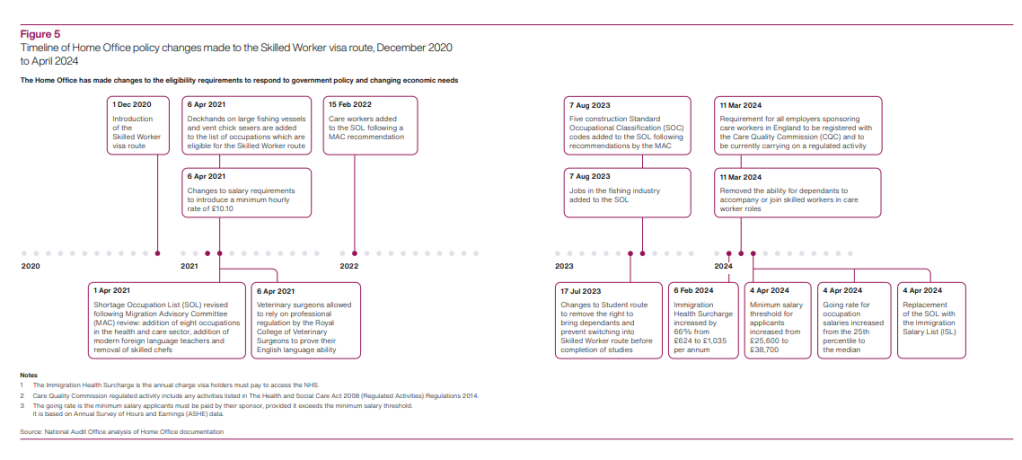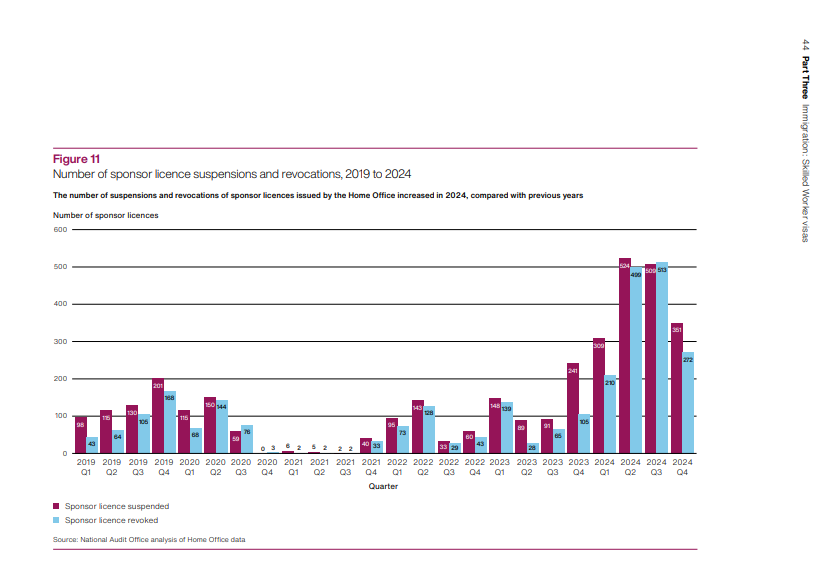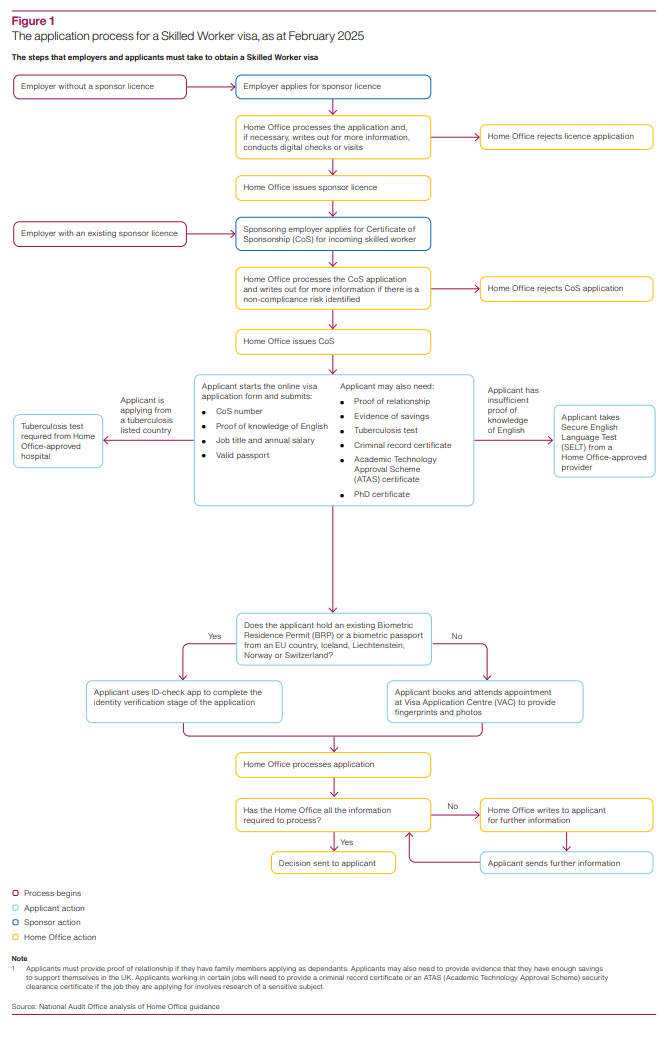The UK's skilled workers visa scheme has been assessed by the National Audit Office on its performance between 2020, when changes were made, and the first ten months of 2024. Problems have been revealed by the report, including exploitation of workers but also alleged abuse of the system itself.
In its report published March 17, Britain’s National Audit Office (NAO), the UK's independent public spending watchdog, pointed out that "multiple changes" made to the skilled worker visa schemes in 2020 have led to some unexpected consequences. These include abuse of some workers, as well as alleged abuses of the system itself.
The scheme was opened in 2020 following Britain’s exit from the European Union, which ended the European free movement rights. It is the main route to working in the UK.
Between 2023 and 2024, the cost of running the scheme amounted to 109 million pounds (around 129 million euros). In that same time period, the government generated an income of approximately 438 million pounds (around 520 million euros), reported the NAO.
Most of the time period assessed by the report was under the former Conservative-led government. However, the scheme is still in operation under the current Labour government, which took power in July 2024.
Read AlsoThe Netherlands: Tax break scheme for skilled migrants
Changes made, without a detailed understanding of possible consequences
According to the NAO report published on March 17, the skilled worker visa route is "a flexible mechanism which helped recruit more care workers from overseas after skill shortages following the pandemic." However, changes were made to the route "without a detailed understanding of potential impacts across different industries and parts of the country," have led to problems.

The NAO, which is set up to make sure that the government delivers value for money for the British taxpayer by examining government expenditures, believes that the government did not fully assess what impact its changes would have. It claims there had been "limited collaboration" between the Home Office and immigration departments to really effectively address the skills shortages from within the domestic labor market.
In 2024, according to government data, 110,500 organizations were registered as sponsors for the skilled worker visa route. In 2023, 509,100 skilled worker visas were issued, and in February 2025, the minimum cost for an applicant for a three-year skilled worker visa stood at 3,656 pounds (around 4,345 euros).
Read AlsoVideo: Finland's hunt for skilled labor
Significant increases in applications
Between 2021 and 2024, applications to the route "increased significantly" by 101 percent. The number of registered sponsors also increased significantly in that time, to an even greater extent, by 185 percent, from 38,800 in 2021 to 110,500 in 2024.
Big changes were made to the entry requirements for care workers in 2022, in effect, care workers were added to the skilled worker route. That resulted in a total of 648,100 applications since those changes took effect.
Some of these changes have had negative impacts for both the UK but also the care workers themselves, believe the report's authors. The changes resulted in an increase in the numbers of applications, as evidenced by the table below. That led to an explosion of the numbers of companies set up as sponsors for these people, and there were abuses in the system in the recruitment process that weren't initially caught.
When the government discovered some of the abuses in the system, they began to revoke some of the sponsor licenses, but that left those who had already arrived on valid visas more vulnerable, because their visas were linked to the sponsor and the job provided by the sponsor. Once their sponsor's license had been revoked, they were in the country without a valid visa, and therefore more vulnerable to exploitation because they would be working without the correct permissions if employed.

Further changes were made in spring 2024, to reduce overall net migration, after it was reported that the then Conservative government was presiding over the greatest increase in net migration since it took power, despite promising to reduce migration to the UK.
Over the course of 2024, the number of skilled worker visas issued fell by 50 percent, with 252,700 fewer visas issued in 2024 than in 2023. Despite this reduction, the NAO report found that "much higher-than-expected numbers have used the skilled worker route since 2021," in part driven by the expansion of the route in 2022 to include care workers.
Read AlsoUK: Increased funding to crack down on people smugglers
Benefits to the economy but also consequences
The NAO reported they had found some benefits to the UK economy from the route, but also negative consequences for the overall net migration figures and in some cases more burden on the health, welfare and social care system through an increase in those needing to use it. These included "an increase in people claiming permanent residency in the UK; an increase in the dependents of skilled worker visa holders entering the UK; and an increase in people on a skilled worker visa who later claimed asylum in the UK."
According to the NAO, between 2022 and the first ten months of 2024, the number of people who entered the UK on skilled worker visas and subsequently claimed asylum had increased 100-fold, from 53 in 2022 to 5,300 in the first ten months of 2024.
Most skilled worker visas last five years. During the audit, the Home Office admitted that it didn’t actually know whether thousands of migrants had returned home once their visas ran out, or whether or not they had remained in Britain.

According to data collated by the NAO, 23 percent of those issued with visas still had a valid visa, 15 percent had applied for indefinite leave to remain, and 62 percent reported their visas had expired, but the Home Office was not able to provide the NAO with data as to how many of that percentage had returned to their home countries.
The NAO found that the Home Office had estimated the number who had left the country in 2020 by analyzing exit checks, but since then had not repeated its analysis.
Read AlsoUnrealized potential: The challenge of 'brain waste' among Europe's skilled migrants
Exploitation of skilled workers
The head of the NAO, Gareth Davies, said he believed the Home Office and other government departments needed to make "better use of data to understand the impacts of changes to the skilled worker visa route, improve customer experience and prevent the exploitation of visa holders."
The exploitation of some of those visa holders, partly because of the changes introduced under the previous government, was another problem highlighted in the NAO’s report.
The full scale of the exploitation of skilled worker visa holders is not yet fully known, admits the NAO report, but it said there is "widespread evidence of exploitation in the care sector." This, stated the NAO report, includes "criminal activity such as trafficking, forced labor or debt bondage, and labor market abuse, such as underpayment of wages, and inappropriate working hours or conditions."

Furthermore, under the previous government, many of the sponsor licenses were revoked by the government, but this left many of the workers who had come with visas via those agencies in the UK without a valid visa.
According to the Gangmasters and Labor Abuse Authority (GLAA), an estimated 34,000 people working in the care sector may have been affected by the Home Office revoking sponsor licenses.
Read AlsoUK: Migrant workers face racism and threats as mob violence continues
Further assessment needed
The NAO recommended that the government evaluate the skilled worker route within the next three months to better understand whether the route was meeting the government's current objectives.

They asked that the Home Office complete an assessment of what happens to people at the end of their visa period by the end of 2025. They also advised that the Home Office work with the Migration Advisory Committee, Skills England and the Industrial Strategy Council and Labor Market Advisory Board, "to agree how to address skills shortages across the labor market."
Finally, the NAO advised the Home Office to "strengthen its approach to tackling non-compliance with visa conditions and potential labor market abuses, including evaluating non-compliance risks when considering any expansion of the skilled worker visa route to include new occupations."
